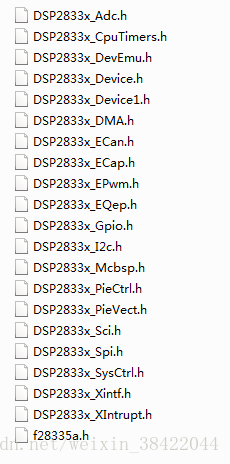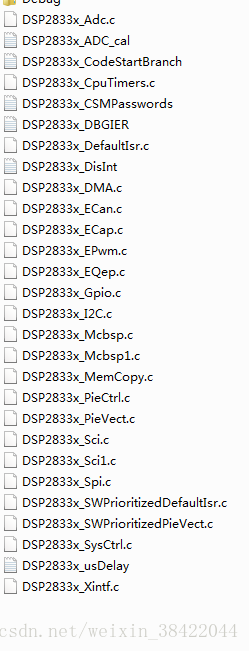这个时候回过头来看整个DSP的程序框架已经很清晰了,对于工程项目中哪些文件需要哪些文件不需要也不会那么迷惘。
再次惠顾一下main函数及整个程序框架:
.h类型的头文件:对每个寄存器的地址进行声明,因为我们编写程序的时候不想写成0X0056(寄存器地址)=0x0001(数据);这样太不方便。

2、下面的文件作用:这是TI为我们搭建好的平台框架。要了解它我们从main函数去看:

在main函数里边第一步InitSysCtrl()系统初始化,该函数就在DSP2833x_SysCtrl.c,可以根据自己的需要关开相应的时钟。
第二步:InitGpio()在DSP2833x_Gpio.c中,可以根据自己需要更改相应的GPIO管脚属性;
第三步:中断相关:
// Step 3. Clear all interrupts and initialize PIE vector table:
// Disable CPU interrupts
DINT;
// Initialize the PIE control registers to their default state.
// The default state is all PIE interrupts disabled and flags
// are cleared.
// This function is found in the DSP2833x_PieCtrl.c file.
InitPieCtrl();
// Disable CPU interrupts and clear all CPU interrupt flags:
IER = 0x0000;
IFR = 0x0000;
// Initialize the PIE vector table with pointers to the shell Interrupt
// Service Routines (ISR).
// This will populate the entire table, even if the interrupt
// is not used in this example. This is useful for debug purposes.
// The shell ISR routines are found in DSP2833x_DefaultIsr.c.
// This function is found in DSP2833x_PieVect.c.
InitPieVectTable();
// Interrupts that are used in this example are re-mapped to
// ISR functions found within this file.
EALLOW; // This is needed to write to EALLOW protected registers
PieVectTable.ECAP1_INT = &ecap1_isr;
EDIS; // This is needed to disable write to EALLOW protected register第四步:初始化外设:但是DSP2833x_InitPeripherals.c这个文件没有找到,所以要用到的外设只能逐个初始化。
// Step 4. Initialize all the Device Peripherals:
// This function is found in DSP2833x_InitPeripherals.c
// InitPeripherals(); // Not required for this example InitEPwmTimer(); // For this example, only initialize the ePWM Timers
InitECapture();最后
以上就是时尚墨镜最近收集整理的关于28335入门总结(1)的全部内容,更多相关28335入门总结(1)内容请搜索靠谱客的其他文章。
本图文内容来源于网友提供,作为学习参考使用,或来自网络收集整理,版权属于原作者所有。








发表评论 取消回复